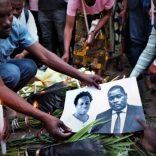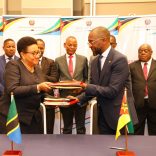Mozambique: Police continue to investigate the murders of Elvino Dias and Paulo Guambe, one year on
Bones still under Macossa bridge, despite police claims

O País
Despite the police claim to have collected the bodies of 11 people dumped under a bridge in Macossa district in the central Mozambican province of Manica, there are still human remains visible under the bridge, the independent television station STV reported on Sunday.
The Commission on Constitutional and Legal Affairs and Human Rights of the Mozambican parliament, the Assembly of the Republic, visited the bridge, accompanied by journalists, and saw the bones, including a human skull, lying in the open.
The chairperson of the Commission, Edson Macuacua, declared “we lament we have found that situation of bodies under the bridge. These are human remains, bones, which show a violation of human rights”.
The Commission said that conditions should be created so that the remains are given a decent burial in an appropriate place.
The remains were discovered in the wake of the story about an alleged mass grave in Gorongosa district, in the neighbouring province of Sofala, published by the Portuguese news agency Lusa, on 28 April.
When the author of that story, Mozambican journalist Andre Catueira, attempted to reach the area of the supposed mass grave, he stumbled across the bodies under the bridge, which is near the boundary between Macossa and Gorongosa districts.
Catueira said he counted 15 bodies under the bridge and in a nearby field. When STV filmed the site a couple of days later, it said there were 13 bodies. But the police say they only collected and buried 11 bodies. This hasty burial led to a protest from the country’s top forensic doctor, Antonio Zacarias, who criticised the police for failing to seal off a crime scene, and for making no attempt to identify the victims.
Zacarias said isolating the scene would have been crucial in an attempt to discover the truth. A detailed investigation could have discovered if the people had been killed at the bridge, or had been brought from elsewhere. With no autopsy, it could not even be firmly stated whether these people had died violent deaths, or had somehow perished naturally.
The Manica provincial police commander, Armando Canheze, initially said there were 13 bodies dumped in Macossa, but later adjusted the total. He claimed the remains had been put in plastic bags and given a decent burial.
But if the police had removed the bodies, how was it that the parliamentary commission could still see bones at the bridge? One local leader old STV that ill-intentioned people must have dug up the remains again – though it seems much more probable that the police had overlooked some of the bones when they collected the remains in May.
At the end of May, journalists discovered more bodies in Macossa, and these do not seem to be included in the Commission’s investigations. According to a dispatch dated 1 June from the French news agency, AFP, there were at least nine bodies in a field a short distance from the bridge.
The local peasant farmer who owns the field, Donca Sabir, said he had told the authorities two months previously, but nobody had come to collect the bodies.
When the AFP reporter visited the bridge he too found that the police had done an incomplete job since “four skulls and some bones are still visible in the sand”.
The Manica branch of the public prosecutor’s office has initiated criminal proceedings against persons unknown with regard to the Macossa bodies, and told STV that, if necessary, the bodies buried by the police could be exhumed. The Manica provincial director of the Criminal Investigation Police (PIC), Adrissa Napovo, said his team is working to find those responsible for what he called “a massacre”.












Leave a Reply
Be the First to Comment!
You must be logged in to post a comment.
You must be logged in to post a comment.